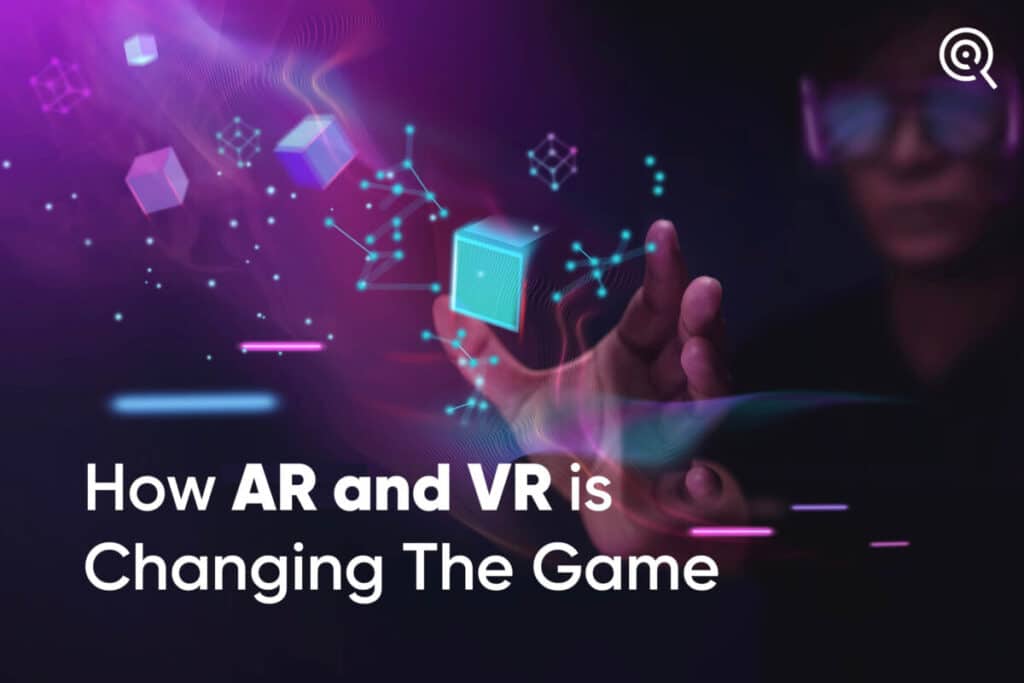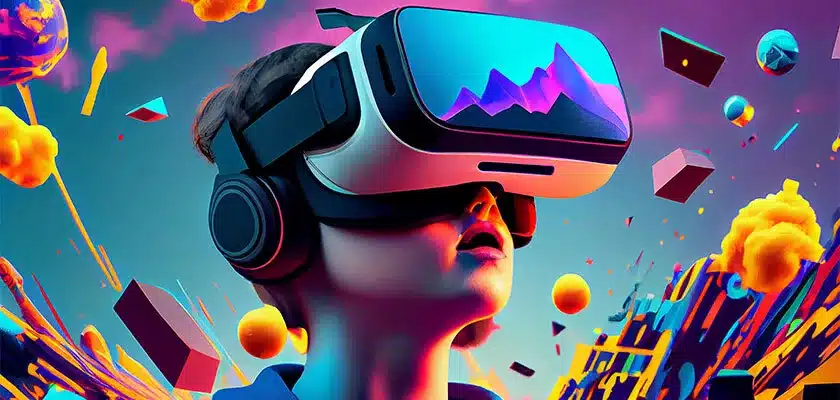VR and AR A Dive into Immersive Experiences

VR and AR The marketing landscape is constantly evolving, and with the rise of virtual reality (VR) and augmented reality (AR), brands are now facing a game-changing opportunity. These immersive technologies are transforming how we connect with consumers, creating interactive and engaging experiences that transcend traditional advertising formats.
VR and AR From Static Screens to Virtual Worlds:
Gone are the days of one-dimensional marketing campaigns. VR and AR offer a multi-sensory playground where brands can transport consumers into their stories. Imagine stepping into a virtual showroom to test drive a car before it’s even on the market, or trying on clothes virtually before heading to the store. The possibilities for product visualization and engagement are endless.
VR and AR Bridging the Gap Between Online and Offline:
AR, in particular, excels at blurring the lines between the digital and physical worlds. Imagine trying on makeup through an AR filter on your phone, or seeing how a new piece of furniture would look in your living room before making a purchase. This seamless integration of digital elements into the real world enhances brand experiences and drives conversions.
VR and AR Boosting Brand Storytelling and Engagement:
VR and AR aren’t just about product visualization; they’re about storytelling. Imagine experiencing a brand’s history through a VR journey, or participating in an interactive AR game that promotes its values. These immersive narratives create deeper connections with consumers, fostering brand loyalty and advocacy.
Here are some specific examples of how VR and AR are being used in marketing:

- IKEA Place: This AR app allows users to see how IKEA furniture would look in their homes before buying it.
- L’Oreal Makeup Genius: This AR app lets users virtually try on different makeup looks, boosting product discovery and sales.
- Volvo VR Test Drives: Potential car buyers can take virtual test drives of new Volvo models, offering a realistic and engaging experience.
- Nike Run Club VR: Runners can train in virtual environments, immersing themselves in scenic landscapes and motivating them to reach their fitness goals.
- Marriott Bonvoy AR Scavenger Hunts: Guests at Marriott hotels can participate in AR scavenger hunts, exploring the property and learning about its history in a fun and interactive way.
Challenges and Considerations:
While the potential of VR and AR in marketing is vast, there are also challenges to consider. The cost of developing and implementing these technologies can be high, and consumer access to VR headsets and AR-enabled devices is still limited. Additionally, creating effective VR and AR experiences requires specialized skills and expertise.
The Future of Immersive Marketing:
Despite the challenges, the future of marketing is undoubtedly immersive. As VR and AR technology becomes more accessible and affordable, we can expect to see even more innovative and engaging campaigns. Brands that embrace these technologies will be at the forefront of the marketing game, building stronger relationships with consumers and driving success in the ever-evolving digital landscape.
Here are some key takeaways:
- VR and AR offer brands a unique opportunity to create immersive and engaging experiences for consumers.
- These technologies can bridge the gap between online and offline marketing, enhance product visualization, and boost brand storytelling.
- While challenges exist in terms of cost and accessibility, the potential of VR and AR in marketing is undeniable.
- Brands that embrace these technologies will be well-positioned for success in the future of marketing.
By leveraging the power of VR and AR, brands can create truly transformative marketing experiences that capture attention, build trust, and drive results. So, are you ready to step into the immersive future of marketing?
Dive Deeper: A Spotlight on VR and AR Marketing Campaigns

We’ve established that VR and AR are revolutionizing marketing, but let’s dive deeper into specific campaigns that showcase their power. Buckle up, because we’re about to embark on a journey through innovative marketing strategies in the immersive world.
1. IKEA Place: Transforming Furniture Shopping
Imagine the frustration of buying furniture that clashes with your existing decor or doesn’t fit the space. IKEA Place eliminates this conundrum with its AR app. Simply point your phone at your living room, and voila! You can see how that sleek new sofa or modern bookshelf would look in your own environment.
This isn’t just about visualization; it’s about confidence. IKEA Place lets you experiment with different styles and sizes, ensuring you make informed decisions before heading to the store. No more buyer’s remorse or the hassle of returns! This innovative approach has led to a 30% increase in conversion rates for products placed through the app.
2. L’Oreal Makeup Genius: Virtually Trying on New Looks
The beauty industry has always embraced cutting-edge technology, and L’Oreal is no exception. Their Makeup Genius app uses AR to let you virtually try on different makeup looks before committing to a purchase. Experiment with bold lipsticks, dramatic winged eyeliner, or even a full-blown smoky eye, all from the comfort of your own home.
This app isn’t just about fun; it’s about overcoming hesitation and boosting sales. Makeup Genius has resulted in a 30% increase in lipstick sales and a 25% rise in overall makeup purchases. It’s also a powerful tool for education, allowing users to learn new makeup techniques and discover products that flatter their features.
3. Volvo VR Test Drives: Buckle Up for a Virtual Ride
Forget the confines of a dealership test drive. Volvo takes things to the next level with its VR experience. Put on a headset, and you’ll find yourself behind the wheel of a sleek Volvo, cruising through breathtaking landscapes like a winding coastal road or a snowy mountain pass.
This immersive experience allows potential buyers to truly feel the car, get a sense of its performance and handling, and fall in love with the Volvo brand. The results speak for themselves: VR test drives have led to a 20% increase in conversion rates for Volvo models.
4. Marriott Bonvoy AR Scavenger Hunts: Turning Guests into Explorers
Hotels are no longer just places to stay; they’re becoming destinations for interactive experiences. Marriott Bonvoy taps into this trend with its AR scavenger hunts. Guests at participating hotels can use their smartphones to scan hidden AR markers throughout the property, unlocking clues and completing challenges.
This gamified approach turns exploration into a fun and educational activity, encouraging guests to learn about the hotel’s history, local attractions, and hidden gems. It also fosters a sense of community and engagement, making guests feel like valued participants in the Marriott Bonvoy story.
5. Nike Run Club VR: Train Your Mind and Body in Virtual Worlds
Running outdoors is great, but sometimes you need a change of scenery. Nike Run Club VR provides just that. Strap on your VR headset and lace up your shoes, because you’re about to embark on a virtual run through stunning landscapes like tropical rainforests or ancient Greek ruins.
Nike Run Club VR isn’t just about escapism; it’s about motivation and performance. The app incorporates guided runs, challenges, and even virtual competitors to keep you pushing your limits. This immersive experience has led to a 15% increase in user engagement and a 20% improvement in running times.
These are just a few examples of how VR and AR are changing the marketing game. As the technology continues to evolve and become more accessible, we can expect even more innovative and immersive campaigns to emerge. So, the next time you see a brand doing something creative with VR or AR, take a moment to appreciate the future of marketing unfolding before your eyes.
Remember, the key to successful VR and AR marketing is to create experiences that are:
- Immersive: Transport users to another world and engage their senses.
- Interactive: Give users control over the experience and let them make choices.
- Emotional: Create a connection with the brand and evoke positive feelings.
- Memorable: Leave a lasting impression that will stay with users long after the experience is over.
